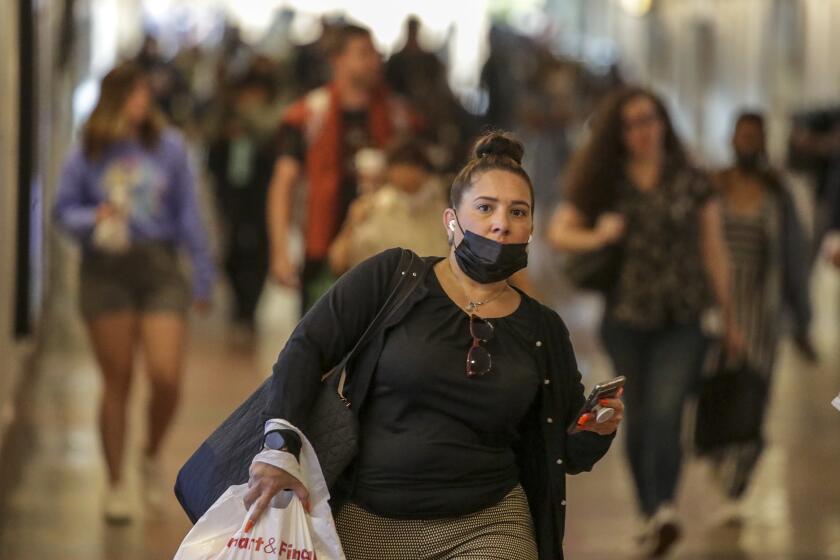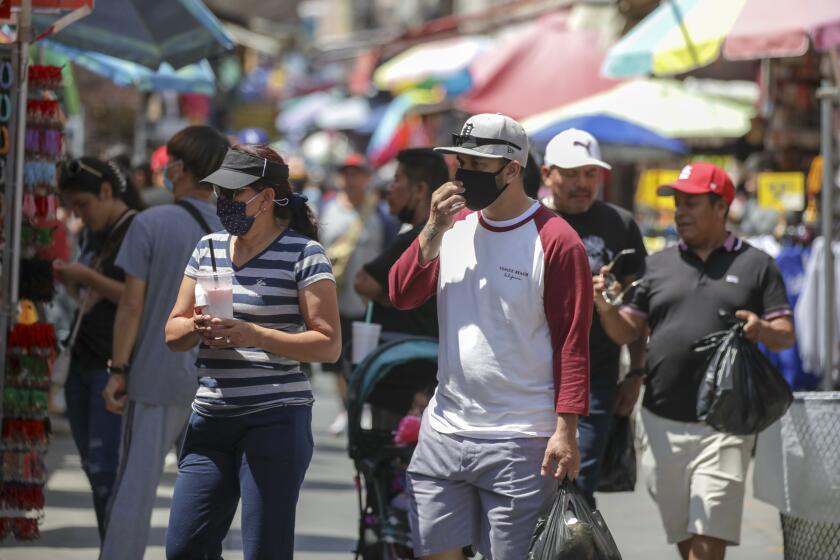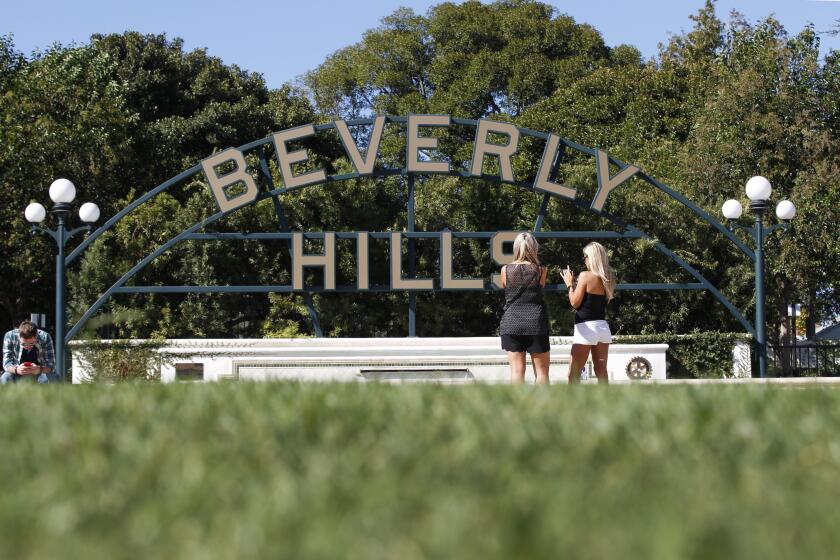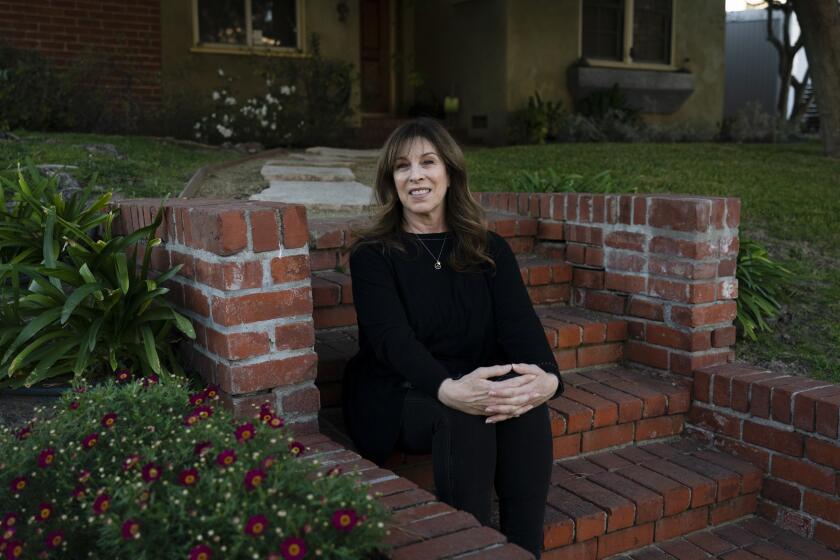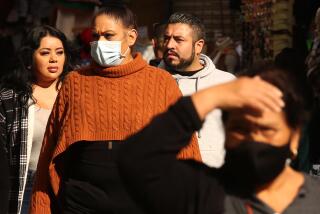L.A. County could avoid mask mandate this week as coronavirus cases decline
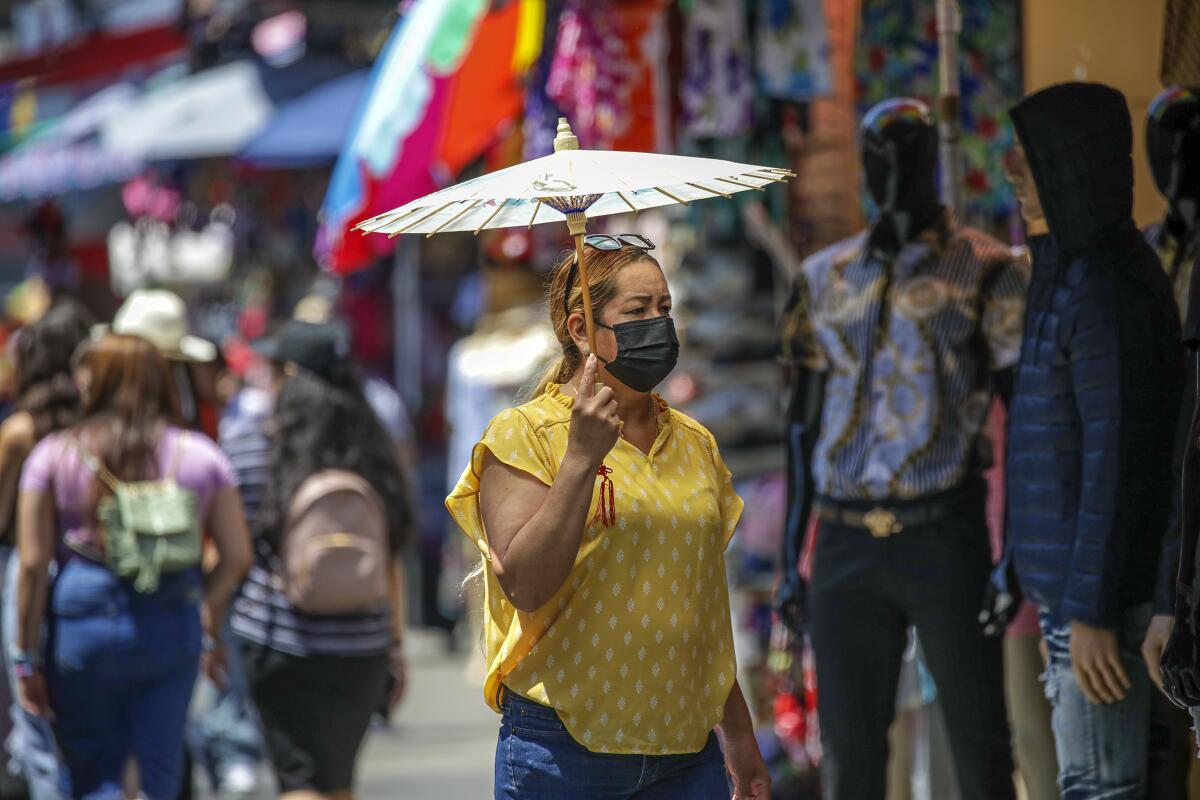
- Share via
Recent declines in cases and coronavirus-positive hospitalizations could pull Los Angeles County back from the brink of a new universal public indoor mask mandate.
Although a decision on whether to impose the long-looming order won’t come until later this week, health officials noted Tuesday that improvements in some COVID-19 metrics might merit a delay.
Such a pause would mark a major turnaround for the nation’s most populous county. A mask mandate appeared likely as of the end of last week, much to the chagrin of some residents, business groups and elected leaders who characterized it as an unnecessary and ineffectual overreach.
Although it’s too soon to say whether this latest wave has peaked — especially as the ultra-contagious BA.5 Omicron subvariant is still widespread — there are some hopeful signs.
Weekly coronavirus cases, while showing signs of flattening in L.A. County, remain elevated as a decision on reimposing an indoor mask mandate looms.
On July 20, 1,329 coronavirus-positive patients were hospitalized countywide. That total plunged to 1,200 by Friday before creeping up again over the weekend, to 1,286 as of Monday.
As of Tuesday afternoon, L.A. County was averaging about 6,000 coronavirus cases a day over the previous week, down 11% from the prior week’s average of 6,700 cases a day. On a per-capita basis, the latest rate is 417 cases a week for every 100,000 residents. A case rate of 100 or more is considered high.
A flattening of coronavirus cases in L.A. County began to be detected in the middle of last week, and on Friday, L.A. County started to record week-over-week declines.
Cases are also falling statewide. California reported an average of 17,000 a day over the last week, down 17% from the prior week.
“It’s important to note that we had three instances earlier this spring and summer where we saw dips in cases that were followed shortly by increases,” Public Health Director Barbara Ferrer told the county Board of Supervisors on Tuesday. “So it’s important for us to continue to be cautious and prepared for layering in additional protections.”
Ferrer had previously said the county could hold off on a mandate if transmission showed pronounced signs of slowing.
Ferrer had said L.A. County would reimpose an indoor mask mandate if it reached the high COVID-19 community level defined by the U.S. Centers for Disease Control and Prevention and remained there for two consecutive weeks.
Placement in that category means a county is recording both a significant amount of community transmission and at least 10 new weekly coronavirus-positive hospitalizations for every 100,000 residents.
L.A. County entered the high COVID-19 community level July 14 and remained there last week. L.A. County makes its determination on which community level it sits every Thursday, using criteria established by the CDC.
But “should we see sustained decreases in cases, or the rate of hospital admissions moves closer to the threshold for medium, we will pause implementation of universal indoor masking as we closely monitor our transmission rates,” Ferrer said.
L.A. County coronavirus weekly death rate 70% higher than in Bay Area: Why so much worse?
If issued, a renewed face covering order would go into effect Friday and apply indoors for anyone age 2 or older at a host of establishments and venues, including shared office space, manufacturing and retail settings, event spaces, restaurants and bars, gyms and yoga studios, educational settings and children’s programs.
Public health officials largely characterize face coverings as a low-impact way to help tamp down transmission in indoor settings, where the risk of coronavirus spread is generally higher. Both the L.A. County and California departments of public health strongly recommend residents mask up while indoors in public.
However, when the coronavirus is spreading widely and sending more people to the hospital, Ferrer has argued it makes sense to move from a recommendation to a requirement. Doing so, she said, would protect not only clients and patrons but also the county’s workforce and its more vulnerable residents.
“No one is suggesting that we need to wear masks forever, rather, that [there] are likely to be short periods of time when it makes sense,” she said.
The City Council votes not to enforce an indoor mask rule, which county officials plan to issue unless COVID rates improve.
But opponents have bristled, arguing such a measure is not needed in a time when vaccines and therapeutics are plentiful, testing is readily available and hospitals are nowhere near as stressed as they were earlier in the pandemic. Particularly objectionable to some is the potential return of masking in schools, which has long been a fiercely debated concept throughout California and the nation.
It’s nonsensical, critics say, for L.A. County to consider a new order when no other part of California is doing likewise. And some business groups voiced concerns that the move could hamper their operations, prompt shoppers to take their money elsewhere or put workers in the position of enforcing rules many no longer want to follow.
Although she is personally “all for masking,” Supervisor Kathryn Barger said Tuesday that she’s adamantly opposed to a mandate “because I truly do believe it’s going to have the opposite effect.”
In an open letter Monday, Barger wrote that she believes such orders are polarizing, unenforceable and “actually distract our collective efforts to decrease COVID-19 infection rates.”
“We have not fully examined nor understand the costs associated with imposing masking mandates among our children and youth,” Barger wrote. “I’ve heard loud and clear from parents and caregivers who are witnessing the social-emotional toll our county’s children are shouldering. Their anxiety and depression are palpable.”
The latest maps and charts on the spread of COVID-19 in Los Angeles County, including cases, deaths, closures and restrictions.
Supervisor Janice Hahn said her preference would be to stay aligned with the state — which strongly recommends, but does not require, masking indoors while in public.
She suggested that new mask rules should also be more limited to start with, perhaps covering just places such as grocery stores and pharmacies.
“Local businesses I know have been telling my office that they’re concerned about having to enforce this mask mandate when such a large portion of the population is against it,” Hahn said. “They just don’t feel like that’s why they went into small business was to, sort of, get in fights with their customers.”
Hahn also said she’s concerned implementing a mandate now could jeopardize the county’s ability to persuade people to mask up should a more severe surge strike in the future.
“I’m worried, to be honest with you, that we’re losing the trust this time of a portion of the public that has actually been with us up until this point,” she said.
Supervisor Sheila Kuehl, however, said she’s struck by “the blowback from a number — though not a really significant number — of sort of snowflake weepies about how oppressive it is to wear a mask.”
Ferrer has said she is hopeful that, should a mask order be reinstated, many residents would adhere to it. She said that the rules would require businesses to post signs informing the public of the mask-wearing requirement and that the county public health department would not ask employees to enforce the rules.
Health officials say it’s OK to live your life, but it’s smart to ramp up protections, such as masking, testing before events and having good ventilation.
One of the major objections to a new mask mandate is the fact that most of those getting infected nowadays are not falling seriously ill — a trend officials and experts credit to robust vaccine coverage and ready availability of treatments, as well as general changes in the nature of the coronavirus itself.
So far, the high point of hospitalizations in this latest wave is lower than the peak of any previous surge. And officials note many coronavirus-positive patients are not being treated specifically for COVID-19 but incidentally tested positive upon admission for other reasons.
“I think now that we’re seeing that fewer people are getting serious cases of COVID, they just don’t really believe this mandate is necessary,” Hahn said.
Although the overall burden of the disease is far lower than previously in the pandemic, health officials note that doesn’t mean it isn’t having an effect.
The order, which could go into effect as soon as July 29, has raised concerns among business groups and sparked questions about its necessity.
Dr. Christina Ghaly, the county’s health services director, said she’s not concerned that any of the county’s four public hospitals are at risk of being overwhelmed. But, because of the high level of community transmission, she said a number of staffers are being infected and unable to work.
“In hospitals, that means that beds are closed or that it might take longer to be seen in an emergency department,” she said. “It has several ways in which there’s an impact on facilities.”
And even if they don’t end up requiring a hospital stay, many patients with symptoms consistent with COVID-19 are still visiting emergency departments and urgent care centers.
“The vast majority don’t need to be admitted. They’re sent home. But that’s still a lot of volume that’s coming into the emergency department,” Ghaly said. “We’re also seeing that backup in the [Emergency Medical Services] system with long ‘wall times’ — wait times for ambulances in emergency departments. That has a negative impact on the system overall because the ambulances can’t get back out to the streets.”
Supervisor Holly Mitchell, who chairs the Board of Supervisors, said she’s concerned such personnel effects “could really plummet us into a situation where our healthcare infrastructure is compromised.”
As unprecedented numbers of Omicron subvariants continue to fuel a new coronavirus wave, there is growing alarm about long COVID, in which symptoms or increased risk of illness can persist for months or even years.
For some, COVID-19 also remains a serious and dangerous foe.
Over the first half of this year, nearly 4,400 people died of the disease in L.A. County — twice as high as the typical six-month average number of deaths from drug overdoses, the flu and car crashes combined, Ferrer said.
L.A. County’s weekly coronavirus death rate is starting to climb again. As of Tuesday, L.A. County was recording 106 COVID-19 deaths a week, a 23% week-over-week increase. A month ago, L.A. County was reporting about 50 deaths a week.
The weekly per capita death rate for L.A. County — 105 deaths a week for every 10 million residents — is 67% worse than the San Francisco Bay Area’s, which reports 63 deaths a week for every 10 million residents.
“When you have this high a rate of transmission, it will lead to, tragically, more deaths,” Ferrer said. “And I think the question everyone has to ask themselves is: How much death do you want to tolerate before you ask people during these extraordinary times of high transmission to put their mask back on?”
More to Read
Sign up for Essential California
The most important California stories and recommendations in your inbox every morning.
You may occasionally receive promotional content from the Los Angeles Times.
